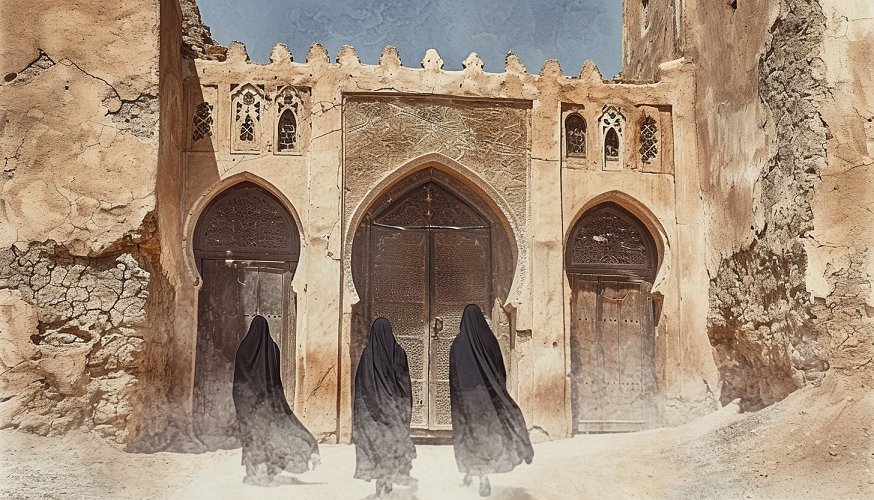In the early 19th century, James Wellsted embarked on a journey through the Arabian Peninsula, chronicling his experiences in the book “Travels in Arabia.” This exploration offers a detailed glimpse into the diverse landscapes, cultures, and daily life in Oman. Wellsted’s narrative spans from the rugged mountains to the intricate social fabric of Omani society, capturing encounters with the Bedouins, the natural beauty of towns like Samad and Nizwa, and the stark contrasts between his preconceptions of Arabia and the reality he witnessed.
Journey and Landscape
James Wellsted’s traversal of Oman begins with a vivid depiction of its terrain, marked by an encounter with the mountains over Sur. The journey unfolds across a landscape dotted with limestone hills of pyramidal shape and rugged outlines. These geological formations, devoid of vegetation, stand in stark contrast to the grassy knolls and woody tracts that emerge towards sunset, painting a picture of Oman’s diverse topography.
As night falls, the expedition encounters a peculiar challenge: the loss of their path. Wellsted observes the camels’ instinctive reaction to this predicament. The animals display a remarkable sagacity, finding the trail anew, yet not without a hint of what Wellsted describes as “spirit of devilry.” This episode culminates in a moment of chaos, as the camels, in their frenzy, scatter and overturn their loads, prompting the decision to halt for the night.
The chosen resting spot, a hollow preferred by the Bedouins for its shelter from the wind and concealment for their fires, serves as the setting for an intimate glimpse into Bedouin nighttime customs. Wellsted notes their unique practice of sleeping: stripping off their attire, they burrow into the sand, covering themselves with their garments for warmth. This method, alongside the strategic placement of their weapons for easy access, reveals a blend of ingenuity and readiness that characterises the Bedouin way of life.
The Bedowins have a singular mode of sleeping ; they strip themselves of all their clothes, and having dug a hole in the sand, pile these, and whatever they can get in addition, over them; the sword, shield, and matchlock are placed by their side, and so disposed as to be ready for immediate use.
James Wellsted: Travels in Arabia
The air in Oman’s oases, while cooler, lacks the clarity and purity of the regions left behind. Wellsted shares an observation that the air of Oman’s interior, particularly within oases, is reputedly unhealthy during the cold season, a claim his subsequent experiences would unfortunately affirm. This initial foray into Oman’s interior landscape and Bedouin customs sets the stage for Wellsted’s journey, marked by the natural beauty and cultural richness of this Arabian land.
The air of Oman… is considered to be proverbially unhealthy in the cold season ; especially within the oases. Bedowins from the Desert rarely reside there three or four days without being attacked with violent fevers
James Wellsted: Travels in Arabia
Incidents on the Journey
One of the most striking aspects of Wellsted’s travels in Oman is the series of encounters and incidents that illuminate the character and customs of its people. A night under the stars brings their first trial, as the neighing of Wellsted’s horse alerts them to the approach of Bedouins. This encounter, fraught with tension, showcases the vigilance and preparedness of Wellsted’s party. In an instant, every man is on his feet, weapons at the ready, highlighting the ever-present threat of thieves in the desert and the swift response it necessitates. However, the resolution of this encounter, without loss or conflict, speaks to the cautious harmony maintained by travellers and locals alike.
The approach of some Bedowins being this night discovered by the neighing of my horse, in an instant every individual was upon his feet with his matchlock ready. The party, which consisted of five or six, finding themselves discovered, were now stealing off, and I had some difficulty in preventing our party from firing on them.
James Wellsted: Travels in Arabia
The narrative then shifts to a lighter, yet deeply cultural moment involving a discussion about the Bedouins’ attachment to their camels. Wellsted recounts a humorous exchange with Hamed, leading to a demonstration of this bond that nearly escalates into violence. Hamed’s interaction with a passing Arab, where he jests about the man’s camel, results in an immediate and heated response. This incident, diffused only by the intervention of Wellsted’s party, underscores the deep respect and affection Bedouins hold for their camels, as well as the serious offence taken to any perceived slight against them.

May God Almighty break the leg of your camel!” bawled out Hamed to the foremost of the party, who was riding somewhat in advance of the others. Without a moment’s hesitation the stranger threw himself from his beast, and advanced sword in hand on Hamed, who would probably have had but little reason to congratulate himself on his experiment, if several of our party had not thrown them selves before him, and explained the story.
James Wellsted: Travels in Arabia
A visit to the Sheikh of Samad introduces a different facet of Arabian culture: the profound hospitality and strict adherence to tradition. Wellsted is invited to breakfast within the Sheikh’s fortress, a place of spartan beauty and strength. The Sheikh’s reluctance to join his guests at the meal, insisting instead on serving them, is a testament to the Arab code of hospitality, where ensuring the guest’s comfort is paramount. Only through Wellsted’s insistence does the Sheikh finally partake, revealing the delicate balance between honouring guests and participating as one.
Our meal, after the usual style, was sumptuous and plentiful; but so strictly do the Arabs regard the laws of hospitality, that it required much entreaty to induce our host, a man of high birth, to seat himself with us. This originates in a prevalent belief that if he partakes of the meal he will neither have leisure nor opportunity to look after his guests, and he, therefore, insisted upon waiting on us in the capacity of an attendant.
James Wellsted: Travels in Arabia
Cultural Observations and Anecdotes
Wellsted’s journey continues to be punctuated with keen observations and anecdotes that delve deeper into the cultural fabric of Oman. The unexpected arrival of Lieutenant Whitelock, travelling with a purpose similar to Wellsted’s but in native attire, signifies the blending of Western curiosity with Arabian tradition. Their decision to journey together, respecting and adapting to local customs, reflects a mutual quest for understanding and cultural immersion.
In the evening I was joined, most unexpectedly, by Lieutenant Whitelock, who was travelling with leave of absence, in order to acquire a knowledge of Arabic. As it suited both our views, it was agreed that we should proceed together. He has assumed the native dress, but I still retain that of England.
James Wellsted: Travels in Arabia
The narrative then leads us into the heart of Samad, where Wellsted is invited into the Sheikh’s fortress. This setting, stark in its simplicity yet imposing in its construction, becomes a canvas for Wellsted to paint a picture of Arabian domesticity and architectural ingenuity. The fortress, with its spacious rooms, devoid of furniture but rich in symbolism with weapons and riding gear prominently displayed, underscores the Bedouins’ readiness for conflict and their deep connection to their steeds.
A significant cultural insight is offered through the depiction of a young Bedouin boy, who, despite his youth, commands respect and authority within the camp. This boy’s presence and conduct exemplify the early maturation expected of Bedouin children, thrust into adult roles and responsibilities. Wellsted’s amusement at the boy’s gravitas and his role in managing access to the tent highlight the unique social structure where youth are not merely seen but heard and heeded.
It may be observed, generally, of the Arabs, and particularly of the Bedowins, that their boys share the confidence and the councils of the men at a very early age ; and on several other occasions I have seen their youths exert their influence in a manner that to us would appear preposterous. But it is a part of their system of education to cease treating them as children at a very early period, and they acquire, therefore, the gravity and demeanour of men at an age when our youth are yet following frivolous pursuits, and being birched into propriety of conduct and manners.
James Wellsted: Travels in Arabia
Adventures and Discoveries
As Wellsted’s expedition delves deeper into Oman, his narrative unfolds with adventures and discoveries that encapsulate the essence of exploration in the early 19th century. The journey to Wadi Ethelee offers a vibrant tableau of the natural bounty of Oman, where the Acacia vera trees stand tall, their branches laden with gum arabic. This lush scenery, teeming with antelopes and partridges, provides a fertile hunting ground, showcasing the rich biodiversity that lies beyond the arid stereotype of Arabian landscapes.

The camaraderie between Wellsted and his guide, old Saaf, during their successful hunt in Wadi Ethelee, highlights the shared human connection with nature and the thrill of the chase, transcending cultural barriers. This moment of triumph, with the dogs in a spirited pursuit of an antelope, captures the raw beauty and the primal joy of hunting, a stark contrast to the previous encounters and discussions that focused on social customs and cultural nuances.
In reflecting on Omani society, Wellsted paints a picture of a community that is deeply rooted in its traditions and values, yet open to moments of wonder and new experiences. His observations offer a window into the heart of 19th-century Oman, revealing a society that navigates the challenges of its environment with grace, hospitality, and a profound sense of community. Through Wellsted’s contribution to Oman travel literature, readers gain an appreciation for the rich cultural tapestry of Oman, marked by a harmonious balance between the preservation of tradition and the embrace of the new.

